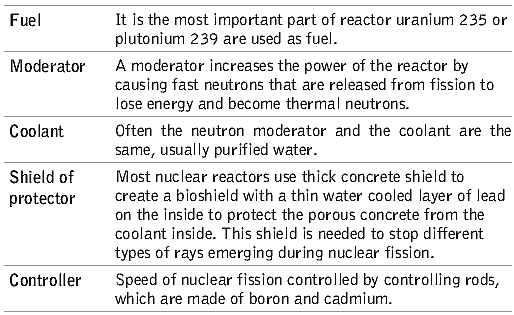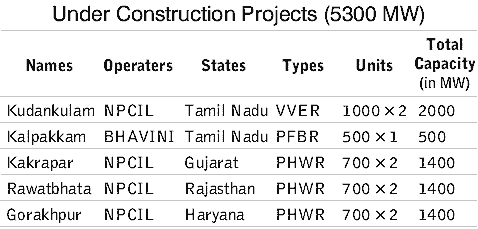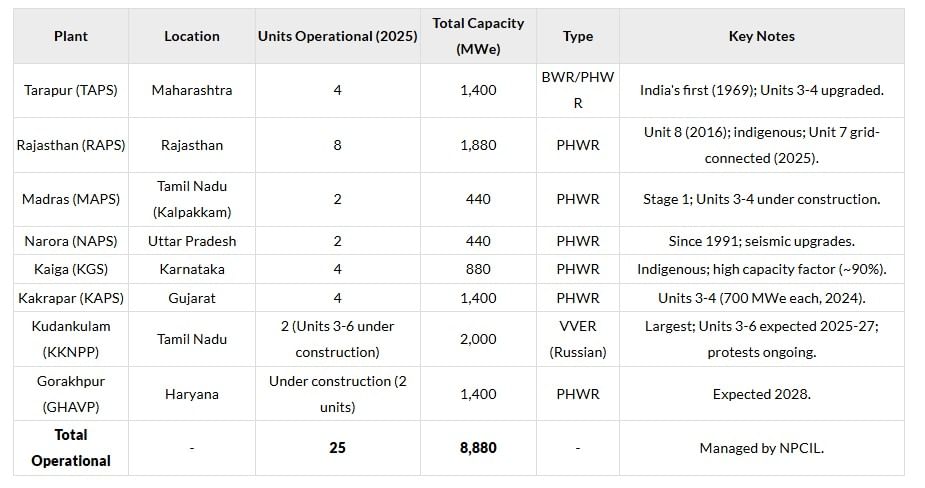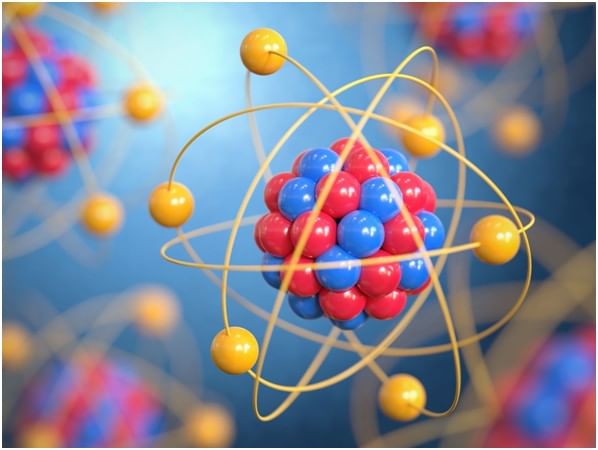Indian Nuclear Programme | General Awareness for SSC CGL PDF Download
Atomic Energy

Atomic energy, also known as nuclear energy, is derived from the reactions of atomic nuclei. It is produced during nuclear reactions, which can occur through either nuclear fission or fusion.
Nuclear Fission
- Nuclear fission is a process where a heavy nucleus splits into two or more lighter nuclei, along with the release of energy.
- This process is utilized in nuclear reactors and atomic bombs.
Nuclear Fusion
- Nuclear fusion involves the combining of two or more lighter nuclei to form a heavier nucleus.
- This reaction only occurs at extremely high temperatures (greater than 106 K) and is thus referred to as thermonuclear.
- In hydrogen bombs, a mixture of Deuterium Oxide (DO) and Tritium Oxide (TO) surrounds an ordinary atom bomb.
Applications of nuclear energy include generating electricity, medical diagnostics and treatment, agricultural improvements, industrial applications, and defense purposes.
Nuclear Reactor/Atomic Reactor
Nuclear reactors are devices designed to maintain a chain reaction that produces a steady flow of neutrons from the fission of heavy nuclei. They are categorized as either research reactors or power reactors.
- Research Reactors: These reactors, operated at universities and research centers, serve multiple purposes including producing radio pharmaceuticals for medical use, testing materials, and conducting research. Examples in India include Cirus, Dhruva, and Kamini.
- Nuclear Chain Reactions: In a chain reaction, neutrons released from fission trigger additional fissions in other nuclei, perpetuating the reaction. This can be controlled (as in nuclear power) or uncontrolled (as in nuclear weapons). For example, a Uranium-235 atom absorbs a neutron and splits into two new neutrons and significant energy. Some of these neutrons continue the reaction by fissioning more Uranium-235 atoms.
Mechanism of Nuclear Power Generation
In nuclear power plants, uranium fuel undergoes fission, generating immense heat. This heat produces high-pressure steam that drives turbines to generate electricity. Light Water Reactors (LWRs) use normal water as both a coolant and a moderator. The coolant removes the heat from the reactor core, while the moderator slows down the neutrons to sustain the chain reaction. Control rods manage the reactor's power by limiting excessive fission. The reactor containment vessel, made of steel, houses the reactor pressure vessel, and the primary water loop transfers heat to the secondary cooling system, which generates steam to drive turbines.
Parts of Nuclear Reactor
Nuclear reactors, where nuclear energy is generated, consist of five main parts.
Development of Nuclear Energy in India
The Atomic Energy Bill of 1948 led to the establishment of the Atomic Energy Commission on August 10, 1948, with Dr. Homi J. Bhabha as its first Chairman. This commission was responsible for formulating and implementing atomic energy policies. The Department of Atomic Energy (DAE) was created on August 3, 1954, under the Prime Minister's direct oversight. On January 3, 1954, the Atomic Energy Establishment, Trombay (AEET), was founded and renamed Bhabha Atomic Research Centre (BARC) in 1967. BARC oversees nuclear reactor research and technology development in India.
Key institutions include:
- Nuclear Power Corporation of India Ltd. (NPCIL): Established 1987; operates all civilian nuclear power plants.
- Bharatiya Nabhikiya Vidyut Nigam Ltd. (BHAVINI): Established 2003; oversees FBR commercialization.
Key personalities:
- Dr. Homi J. Bhabha. Regarded as the father of India’s nuclear programme, he passed away in 1966.
- Dr. Raja Ramanna. He played a significant role in leading the 1974 nuclear test.
- A.P.J. Abdul Kalam. Known for his contributions to missile and nuclear technology.
- Dr. Anil Kakodkar. He served as the Chairman of the Atomic Energy Commission from 2000 to 2009.
- Dr. Rajagopala Chidambaram. He oversaw the nuclear tests conducted in 1998.
Current
India’s Three Stages Nuclear Power Programme
Dr. Homi J. Bhabha outlined a three-stage nuclear power program aimed at utilizing domestic resources:
- Stage I - Pressurised Heavy Water Reactor (PHWR): This stage uses natural uranium-fueled PHWRs to generate electricity and produce plutonium-239 as a by-product.
- Stage II - Fast Breeder Reactor (FBR): FBRs produce more fissile material than they consume. This stage uses a mixed oxide fuel made from plutonium-239 and natural uranium. Plutonium-239 undergoes fission to produce energy, while uranium-238 is converted into additional plutonium-239.
- Stage III - Thorium-based Reactor: This advanced reactor system uses thorium-232 and uranium-233 fuel to sustain a chain reaction.
Nuclear Research Reactors in India
- Apsara: India’s oldest reactor, designed by BARC with UK assistance, was shut down in 2010.
- Cirus: Located in Trombay and built with Canadian help, it was also shut down in 2010.
- Zerlina: An experimental zero-energy reactor built indigenously, decommissioned in 1983.
- Kamini: A research reactor at IGCAR in Kalpakkam, designed to use U-233 as fuel.
- Dhruva: India’s largest research reactor, a key source of weapons-grade plutonium.
- Fast Breeder Test Reactor (FBTR): A liquid metal fast breeder reactor designed jointly by BARC and IGCAR, based on the French Rapsodie design.
- Advanced Heavy Water Reactor (AHWR): Thorium-based; trials ongoing.
Advanced Heavy Water Reactor (AHWR)
This reactor will use thorium-based mixed oxide fuel with a small amount of plutonium. It involves developing indigenous equipment for producing thorium dioxide powder and conducting trials with uranium dioxide, relevant for future 500 MW PHWRs.



Current Nuclear Capacity and Reactors

Development of Higher Technology Accelerator
Atomic accelerators increase the speed of atomic particles, enabling their use in radioisotopy and isotope formation.
- Pulse Electron Accelerator: Used for X-ray and high-frequency microwave applications, such as the KALI-500.
- Radio Telescopy: The National Centre for Radio Astrophysics in Pune, under Tata Institute of Fundamental Research (TIFR), focuses on this research.
- Agricultural Nuclear Technology: Nuclear isotopes are present in soil, plants, animals, and air, and are used in agriculture to improve crop varieties through radiation-induced genetic changes.
Radio Isotopes

In unstable atoms, the nucleus releases a neutron to regain stability, emitting radiation in the process. Such isotopes are known as radioisotopes. All elements with atomic numbers greater than 83 are inherently radioactive, possessing unstable nuclei. Elements with atomic numbers 83 and below have stable isotopes but may also have at least one radioactive isotope. As radioisotopes seek stability, they may undergo transmutation, transforming into new elements. Radioisotopes, by definition, are unstable and emit radiation, while not all isotopes are radioactive.
Applications of Radioisotopes
- Medicine: Used in diagnosing and treating diseases, sterilizing medical products, and other clinical applications.
- Industry and Technology: Applied in material inspection, welding processes, production control, and research.
- Agriculture: Utilized for pest control and food preservation.
- Art: Helps in art restoration and verifying the authenticity of historical or artistic objects.
- Archaeology: Assists in dating geological events and researching historical contexts.
- Pharmacology: Facilitates the study of drug metabolism prior to public release.
Radiocarbon Dating
- Radiocarbon dating is a technique used to determine the age of organic materials such as wood, charcoal, shells, bone, and sediments.
- The age is calculated by comparing the ratios of carbon-14 to carbon-12 in a sample.
- Radiation counters play a role in detecting beta particles emitted from decaying carbon-14, aiding in the dating of artifacts.
Tokamak
- A tokamak is a device that employs a magnetic field to contain plasma in a toroidal, or doughnut-like, shape.
- To ensure plasma stability, the magnetic fields within a tokamak are arranged in a helical configuration. This is achieved by combining both toroidal (around the doughnut) and poloidal (through the cross-section of the doughnut) magnetic fields.
- The concept of the tokamak was developed in the 1950s by Soviet physicists Igor Tamm and Andrei Sakharov.
- The term "tokamak" is an acronym derived from Russian, meaning "Toroidal Chamber with Magnetic Confinement."
ITER
ITER (International Thermonuclear Experimental Reactor) is an international project constructing the largest experimental tokamak nuclear fusion reactor in France. Its goal is to demonstrate the feasibility of nuclear fusion as a viable power source without adverse effects.
Nuclear Waste Management
- Managing radioactive waste involves complex procedures due to its hazardous nature and strict regulatory requirements.
- India has developed self-reliant methods for managing radioactive waste.
- Following the Fukushima disaster in 2011, there has been local opposition to nuclear projects in India, such as the Jaitapur Nuclear Power Project and the Kudankulam Nuclear Power Plant.
Stages in Nuclear Waste Management
- Partitioning: Separates short-lived nuclides from long-lived ones using chemical or electrochemical methods.
- Transmutation: Converts long-lived nuclides into shorter-lived ones through radioactive bombardment.
- Conditioning: Prepares waste for handling, transport, storage, and disposal, often by converting it into a solid form and encasing it in containers.
Types of Radioactive Wastes
- Exempt and Very Low Level Waste (VLLW): Contains minimal radioactivity and is not considered harmful.
- Low-Level Waste (LLW): Includes items like paper, clothing, and filters from hospitals, industries, and the nuclear fuel cycle with low, mostly short-lived radioactivity.
- Intermediate-Level Waste (ILW): Has higher radioactivity and may require shielding.
- High-Level Waste (HLW): Results from the use of uranium fuel in reactors and has high radioactivity.
Nuclear Tests of India
India, as the sixth nuclear power, conducted its first test on May 18, 1974, in Pokhran, Rajasthan, named "Smiling Buddha." On May 11 and 13, 1998, India conducted five tests under Operation "Shakti," including fission, low-yield, and thermonuclear devices.
- Nuclear Triad: INS Arighat (second SSBN) commissioned August 2024; ~180 warheads (SIPRI 2025).
Regulation and Safety
- International Atomic Energy Agency (IAEA): Promotes peaceful nuclear energy use. India contributes to the IAEA’s Nuclear Security Fund. The current Director General is Yukiya Amano, and the IAEA has 180 member states.
- Atomic Energy Regulatory Board (AERB): Established in 1983 under the Atomic Energy Commission, it promotes safety research in nuclear facilities and has a dedicated institute at Kalapakkam.
- Nuclear Supplier Group (NSG): Formed in 1974, this group of 48 countries seeks to prevent nuclear weapon proliferation through export guidelines. India is exempt from the NSG’s restrictions without signing the Non-Proliferation Treaty.
- Non-Proliferation Treaty (NPT): Since 1970; India not signed (with Pakistan, Israel, South Sudan).
- Comprehensive Test Ban Treaty (CTBT): Adopted 1996; India not signed (objections: proliferation, verification).
- Treaty on the Prohibition of Nuclear Weapons (TPNW, 2017): Bans nuclear weapons; 73 ratifications as of September 2025 (recent: Indonesia, Sierra Leone, Solomon Islands). India non-signatory.
Non-Proliferation Treaty (NPT)
The NPT aims to prevent the spread of nuclear weapons, encourage peaceful nuclear cooperation, and advance disarmament. Effective since 1970 and extended indefinitely in 1995, it includes the US, Russia, the UK, France, and China as nuclear weapon states. India, Pakistan, Israel, and South Sudan have not signed the treaty.
India’s Nuclear Doctrine
- No First Use: India commits to not using nuclear weapons first.
- Credible Minimum Deterrent: Ensures a sufficient, survivable, and operationally ready nuclear force with robust command, control, intelligence, and planning.
Nuclear Command Authority
India’s Nuclear Command Authority (NCA), established on January 4, 2003, consists of three tiers: the Political Council (headed by the Prime Minister, authorizing nuclear use), the Executive Council (headed by the National Security Advisor, providing inputs for decisions), and the Strategic Forces Command (responsible for nuclear force administration and operations).
CTBT and India
The Comprehensive Nuclear Test Ban Treaty (CTBT) bans all nuclear explosions and was adopted by the UN General Assembly on September 10, 1996. It has not yet entered into force due to the lack of ratification by eight specific states. India, Pakistan, and North Korea have not signed it, and six other states have signed but not ratified it.
India’s Points of Objections on CTBT
India argues that the CTBT should prevent both horizontal and vertical proliferation, avoid dividing nations into nuclear haves and have-nots, and address concerns about intrusive verification methods and the use of satellite technology.
Kudankulam Nuclear Power Plant Controversy
The Kudankulam Nuclear Power Plant, a joint Russia-India project in Tamil Nadu, faces local opposition due to concerns over the environmental impact of hot water discharge on marine life.
Treaty on the Prohibition of Nuclear Weapons (2017)
Known as the Nuclear Ban Treaty, it is the first legally binding agreement to comprehensively ban nuclear weapons. Adopted on July 7, 2017, it required ratification by at least 50 countries to take effect. As of June 2020, 38 states had ratified it. The treaty was established under the UN General Assembly on December 23, 2016.
India-Signed Action Plan with Russia
On October 5, 2018, during President Vladimir Putin’s visit, India and Russia signed an Action Plan for cooperation in the nuclear sector, planning the development of six nuclear plants in India.
Recent Developments
- Union Budget 2025-26: "Nuclear Energy Mission for Viksit Bharat" with ₹20,000 crore (~$2.3B) for R&D; Atomic Energy Act amendments for private/FDI (up to 49%). Focus: 5 indigenous SMRs by 2033; 40-50 by 2032 for industries (steel, cement). SMR designs: BSMR-200MWe, SMR-55MWe, High-Temp Reactor for captive use.
- International: India-US (Kovvada AP1000); India-France (Jaitapur EPRs, start 2026); India-Russia (Kudankulam 3-6).
- Milestones: PM Modi lays foundation for 2,800 MW plant in Rajasthan (2025). Thorium focus for net-zero 2070.
- Challenges: Uranium imports (Kazakhstan); protests (Jaitapur); global risks (SIPRI 2025 arms race)
|
448 videos|1497 docs|288 tests
|
FAQs on Indian Nuclear Programme - General Awareness for SSC CGL
| 1. What is atomic energy and how is it used in nuclear reactors? |  |
| 2. What is the mechanism of nuclear power generation? |  |
| 3. How has nuclear energy developed in India over the years? |  |
| 4. What is the significance of a tokamak in nuclear energy research? |  |
| 5. How is nuclear waste managed in the nuclear energy industry? |  |
















